本篇为The Rhoton Collection解剖视频中《Orbitozygomatic Approaches 眶颧OZ入路》一章,笔者进行了重新编排。为了更加详细的介绍OZ入路,笔者将在文末结合法国神经外科专家Froelich教授在2020年《Open approaches to the skull base》课程中的详细示范,分步介绍OZ入路。
再次感谢唐寅达医生翻译的字幕!
笔者水平所限,错误之处请批评指正!


眶颧入路
Orbitozygomatic Approaches
对于前、中颅窝,想要得到更广泛的暴露,常需用到眶颧入路。下图(并非眶颧入路)显示的是经过侧裂显露前床突的入路,该入路是保留眶顶的。
Now, for anterior and middle fossa, if we want wide exposure, we're often using orbitozygomatic approach.And here's the approach down the Sylvian fissure to the clinoid,with the orbital roof intact.

再来看看眶颧入路(下图)。上述目标区域已显得表浅得多。其优势包括更宽广的操作视角、更充足的光线,并利于进行颞前和颞下扩展。

我们也已讨论过切除颧弓的优势在于可沿着颞叶得到更为从下往上的视角。

![]()
眶颧入路我们可以选择单骨瓣法,两骨瓣法,三骨瓣法。也可进行改良法保留这一部分颧弓。
下图示单骨瓣法

下图示两骨瓣法


下图示三骨瓣法

下图示改良法。已足以显露前交通复合体区域、前颅窝、侧裂,而不需向下至颧弓。
That gives us access to anterior communicating area,anterior fossa,Sylvian fissure,without going down to the zygomatic arch.
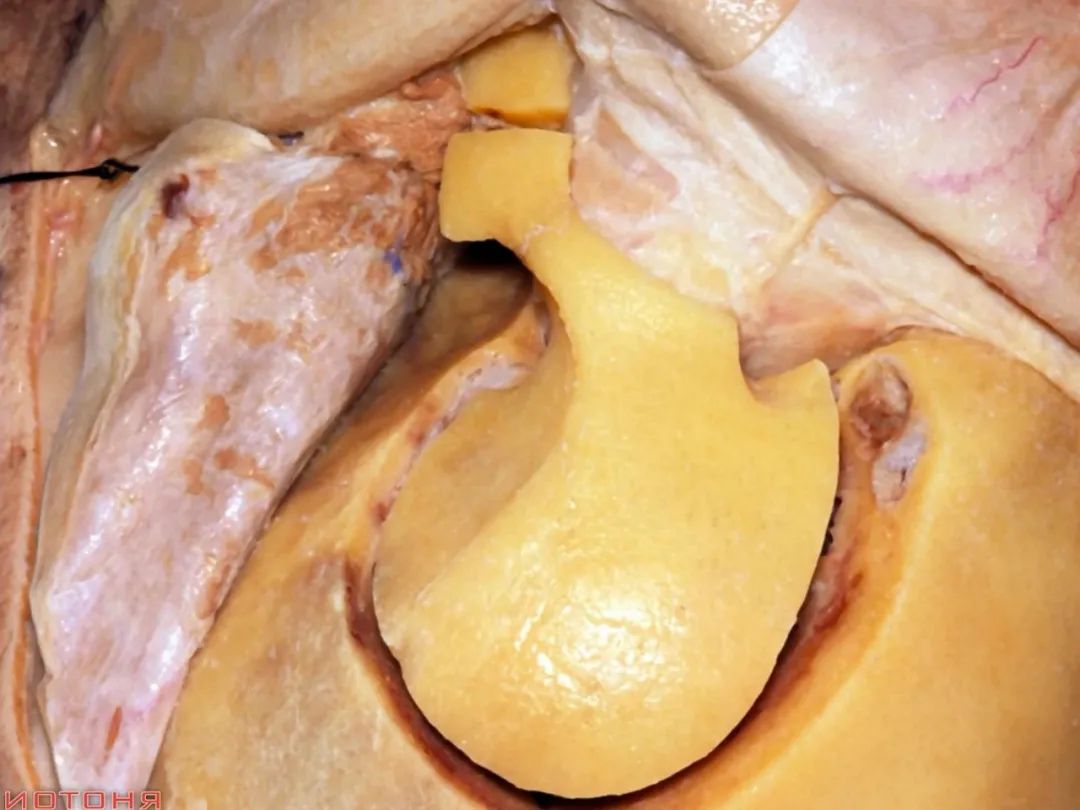
在上述入路中,当掀起帽状腱膜时,在耳前区域,可能会损伤走行于颞肌筋膜的浅面的面神经分支丛,我们需保护面神经的颞支。

因此,当掀起帽状腱膜,暴露颞肌筋膜时,可见颞肌浅面的脂肪垫。颞肌筋膜分为两层:浅层 和 深层。深层仍位于颞肌的浅面。

我们可进行筋膜间分离,将筋膜间脂肪垫、面神经连同帽状腱膜一起翻开。
And we can do an interfascial incision, and fold that fat pad with the facial nerve downward with the galea.

进行搭桥手术时,需保留颞浅动脉。

将前支吻合于大脑中动脉M2段,将后支吻合于最大的皮层支角回动脉。

该入路中,与术后容貌最为相关的肌肉是颞肌。
And then, we...one of the most important muscles in getting a good cosmetic result, is the temporalis muscle.

其中的关键环节就是保护颞肌的神经血管束。对于颞肌,其供血动脉、引流静脉、以及支配的神经,均走行自颞下窝,行于颞肌的深面。
And if you look at...to get a good cosmetic result, you wanna save that neurovascular bundle to this muscle. And if you look at the temporalis muscle, the arterial supply, the venous drainage, and the nervous supply,all come in from the infratemporal fossa to the deep surface of that muscle.
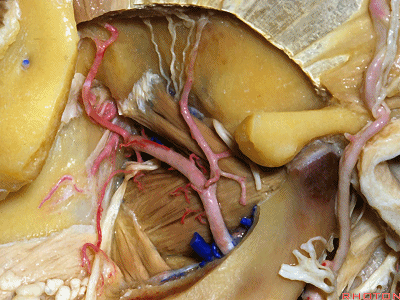
因此,为了保证术后的容貌,翻开颞肌时,须进行仔细的骨膜下分离,从而保留颞肌深面的神经血管束。
So to get a good cosmetic result, when you're folding it downward, you wanna do careful cold subperiosteal dissection that allows the spanservation of this neurovascular bundle on the medial surface of the muscle.

![]()
单骨瓣法
现在来看单骨瓣法眶颧入路。其关键孔(McCarty keyhole)需满足如下要求,即通过该关键孔可进行三个方向的切开,第一切是形成额颞瓣,第二切向下进入眶下裂,第三切是沿着眶顶。
And then, for the one-piece orbitozygomatic approach, we want a keyhole, and out of the keyhole we said...we have three cuts, one into the flap, one down into the inferior orbital fissure,and a third cut out of the keyhole along the orbital roof.

准确的关键孔,其一侧半可见眶筋膜,另一侧半为硬脑膜,眶顶分隔其中。
But a properly placed keyhole exposes periorbita on one side, dura on the other side, and the orbital roof in the center.

这是左侧。已将颞肌向下翻开。额颧缝、蝶颧缝、额蝶缝 这三条骨缝的交界点可作为关键孔的定位标记。关键孔若再靠前,将导致过多的去除眶顶骨质。
Now here we're on the left side. We've folded the temporalis muscle backwards. And so here's three suture junction. This is a good place for keyhole burr hole. If you move it forward, then you save less of the orbital roof when you turn the flap.

沿着额蝶缝,在位于此处三条骨缝的交界点后方钻孔(下图)。此处即为关键孔。
And a good place for the keyhole is on this frontosphenoid suture, just behind this three suture junction. And if you get right on this area with the keyhole, you have periorbita below, dura above, and then orbital roof in the center.

在单骨瓣法中,可跨过颧骨直至眶下裂的颞窝部行骨质切开。
But in the approach, we make one cut across the zygomatic bone here,down to the temporal fossa part of the inferior orbital fissure.

这是单骨瓣法形成的骨瓣。
So this is the one-piece.

![]()
两骨瓣法
两骨瓣法即首先作一翼点开颅的额颞骨瓣。
A two-piece begins with the pterional flap.

随后在硬膜外间隙切开眶顶至眶下裂。这样就可以保留更多的眶顶于骨瓣。下图示眶下裂 。
And then we can make the cuts across the orbital roof from the extradural space.And that allows us to save more of the orbital roof, and we still come across the roof down to the inferior orbital fissure.
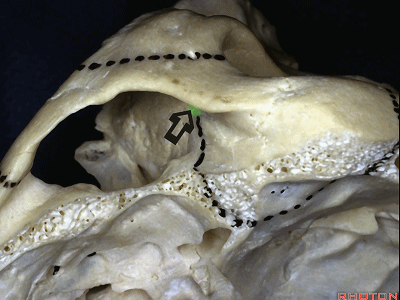
另一切则同样是跨过颧骨至眶下裂。
We have a second cut across the zygomatic bone to the inferior orbital fissure.
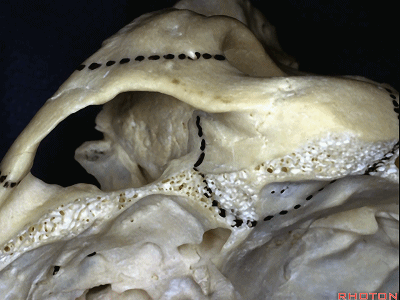
因此,两骨瓣法中,颧弓和眶顶均位于第二块骨瓣上。
But this two-piece includes the zygomatic arch and the orbital roof in the second piece.

从前方来看两骨瓣法,第二块骨瓣中的切开均至眶下裂。由于是从颅内面的硬膜外间隙操作,可紧贴眶上裂外侧缘切开眶顶,而尽可能多地保留眶壁骨质于骨瓣上。
Here's the two-piece,the second piece, the cuts into the inferior orbital fissure. And by being extradural, we can get the cuts in the orbital roof down close to the lateral edge of the superior orbital fissure.

然而 单骨瓣法(下图) 的 关键孔须进入眶内,其位置距离眶上裂前方尚远。因此,单骨瓣法开颅后,仍有较多眶顶骨质残留。在掀开这一单骨瓣后,常需继续咬除残留的眶顶骨质。
Here we just see again the one-piece. The keyhole burr hole comes through in the orbit well anterior to the superior orbital fissure. So that when we do a one-piece,we save...we still have a lot of the orbital roof remaining after we elevate the one-piece flap. We often bite off the orbital roof.

这是两骨瓣法形成的骨瓣。
And So this is the two-piece.

然而 在眶颧骨瓣中,最不需要的部分是连接眶顶和颧弓的这一部分。
Now, of this approach, the part that we need the least is this part connecting the orbital roof with the zygomatic arch.

连于颧弓下方的正是咬肌。切断向上连于颧弓的咬肌,会导致咬肌向下挛缩,从而引起下颌疼痛。
And, attached to this area along here, is the masseter muscle. So that if we do a one-piece, and we disconnect this masseter muscle that attaches above to the zygomatic arch, this muscle tends to clump downward, and cause jaw pain.

因此,可通过改良,避免该区域的暴露和分离,从而保留咬肌于颧弓上。
So that, if we want to, we can avoid this part of the exposure here, and leave the zygomatic arch attached to the muscle.

在颧弓两端先行切断,保留其于咬肌上,即可避免咬肌的离断。
But, by dividing the zygomatic arch anteriorly and posteriorly, and leaving it attached to the muscle,we avoid the problems with the masseter muscle.

因此,可将单骨瓣法改良成第二种 两骨瓣法,可使得颧弓附着于咬肌,一同向下翻开,从而减少术后下颌疼痛的发生率。
And we can do...convert this one-piece to a two-piece, allowing the zygomatic arch to be folded down with the masseter muscle to reduce the possibility of jaw pain with the exposure.

![]()
三骨瓣法
两骨瓣法可进一步改良为 三骨瓣法(笔者更推崇三骨瓣法)。

三骨瓣法,首先我们作一翼点额颞瓣。
Here we start with the pterional flap,

第二块骨瓣,即在下图前后离断颧弓。这部分颧骨我们并不需要切除。
the second piece disconnects the zygomatic arch anteriorly and posteriorly. We don't have to go over the zygomatic bone here.

第三块骨瓣即为眶顶。
And the third piece is the orbital roof, then.

随后我们将颧弓连同咬肌一起翻向下方。骨瓣的还纳也可顺利完成。
And we fold the masseter muscle down with the zygomatic arch attached to it.And it's easy to plate all of this back together.

下图示三骨瓣法骨瓣

![]()
改良的眶颧入路
若仅需暴露前交通复合体区域(下图),则无需利用切除颧弓带来的空间。
when we're going to the anterior communicating area,we don't need the zygomatic arch or that part of the exposure.

此时可作改良的眶颧入路,即仅需切除眶顶和外侧壁。颞部的这些区域并不需要打开。
We can do a modified orbitozygomatic where we go down and just elevate the roof and lateral wall of the orbit.We don't need this area, this temporal area.

这就是改良眶颧入路。
So we do this modified OZ approach.
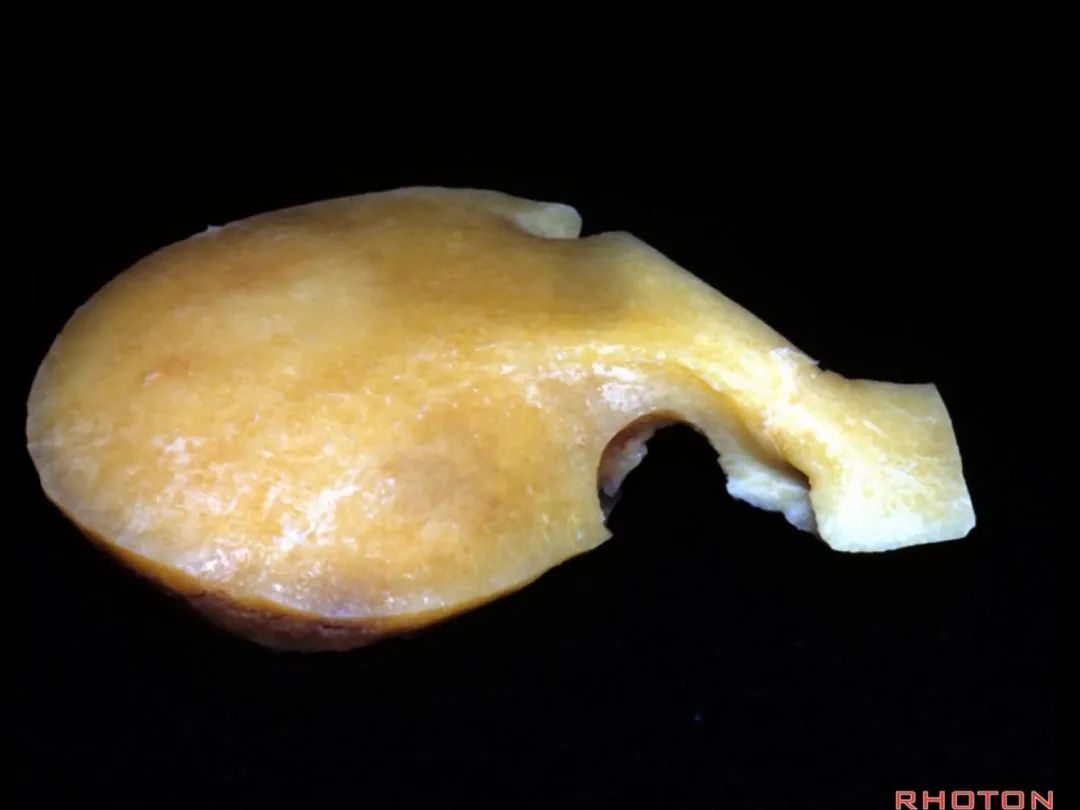
其可显露整个眼眶,可打开侧裂,显露前颅窝、前床突、以及前交通复合体区域。
It gives us all of orbit, access along the Sylvian fissure, anterior fossa, clinoid, over to the anterior communicating area.

眶颧入路可完整暴露眼眶。
We have access to all of the orbit.

可提供眼眶的绝佳暴露。尤其适合处理眶内病变的范围为累及视神经管前方的眶尖区域。
It's a great exposure for orbit. But it's one of the great routes to lesions here involving the area just in front of the optic canal at the orbital apex.


而对于经海绵窦入路,利用的间隙位于颈内动脉与动眼神经之间。通常在后交通动脉下方操作,以避开这些穿支。
And for that transcavernous approach, we get between the carotid and 3rd nerve. We usually work below the communicating to avoid these perforating branches.

首先需切除前床突,随后需开放动眼神经池,用钩刀打开动眼神经池。随后即可暴露后床突和鞍背。
We begin by taking off the anterior clinoid, and then we open the oculomotor cistern, put a hook down the cistern, open the oculomotor cistern. And then we have access to the posterior clinoid and dorsum.

随后在动眼神经内侧,磨除后床突和鞍背,即可经海绵窦向后暴露低位基底动脉分叉部。
And we can work medial to the 3rd nerve, drill off the posterior clinoid and dorsum, and get this transcavernous exposure back to the low basilar bifurcation.

另外,切除颧弓的眶颧入路,也可用于颞下入路。
Now, for those approaches that involve the zygomatic arch that we need to get subtemporal.

以及颞前入路扩展
as well as spantemporal approach
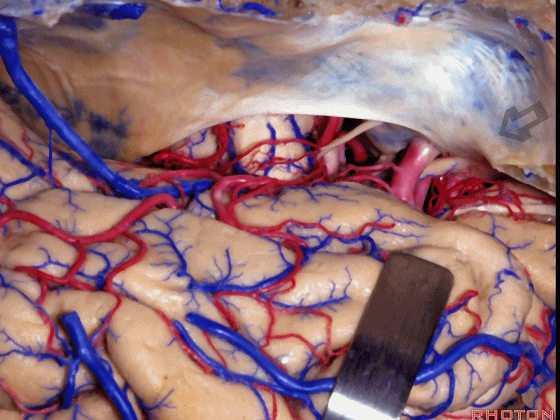
还可进入整个中颅窝,向后甚至可达内听道。
And it allows you access to all of the middle fossa back even to the internal acoustic meatus,

也可磨除岩尖进行岩前入路。这里显示的就是磨除Kawase区域后的岩前入路,以及经中颅窝打开内听道的入路。关于这些解剖的详细内容均在之前讨论过了(详见《颞骨解剖(中颅窝部分)---Rhoton解剖视频学习笔记系列》)。
and through the petrous apex for the anterior petrosectomy approaches. Here we've just drilled out in the Kawase's area, the anterior petrosectomy, and the approach to the internal acoustic meatus.And we covered all of this anatomy in detail yesterday.
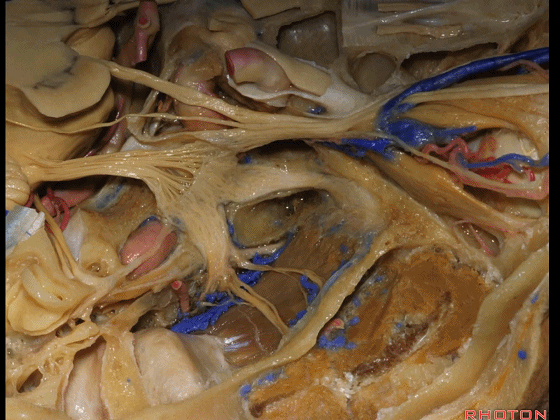
因此,眶颧入路可显露整个前、中颅窝(下图)
So it allows us to access all of this area of anterior and middle fossa.

可以开放侧裂、暴露各基底池。因此,眶颧入路是到达颅底的绝佳入路。
and exposure along the Sylvian fissure,and access to basal cisterns.So OZ approach is a great approach for accessing skull base



额颞眶颧入路分步详解
Fronto-Temporal-Orbito-Zygomatic (FTOZ) approach
额颞眶颧入路(Fronto-Temporal-Orbito-Zygomatic approach. FTOZ)是将翼点入路向颅底方向的进一步扩展,在翼点开颅术基础上切除部分眶顶、眶外侧壁和颧弓以增加颅底显露,使器械和病变部位直接距离比翼点和外侧裂入路更近,为手术提供广阔、多方向的径路以达前、中颅底和颅后窝、斜坡的上1/3。神经内镜筷子技术的发明者法国神经外科专家Froelich教授在2020年《Open approaches to the skull base》课程中,亲自示范了单骨瓣法FTOZ入路,笔者在此结合简单的文字介绍,采用动图的形式呈现。
1.体位、切口
患者仰卧,术侧肩下垫小枕,上半身抬高15-20°,头向下倾斜20°并向对侧旋转30-45°,使术侧颧突位于最高点。
切口起自患侧耳廓前 1cm 内。沿发际线内,向中线方向延伸至对侧。止于对侧瞳孔中线与发际线的交点。颧弓下方切开不超过1cm,以免损伤面神经分支。向下锐性切开头皮,深度至骨膜和颞肌筋膜。尽可能地保留颞浅动脉的后支。颞浅动脉的额支可电凝后切断。

2.用刀刃进行帽状腱膜和颞肌筋膜之间的分离。

3.Froelich教授示范了另一种筋膜间技术:在颧骨额突及眶缘的后方2.5-3m处平行于颞上线切开一小段颞肌
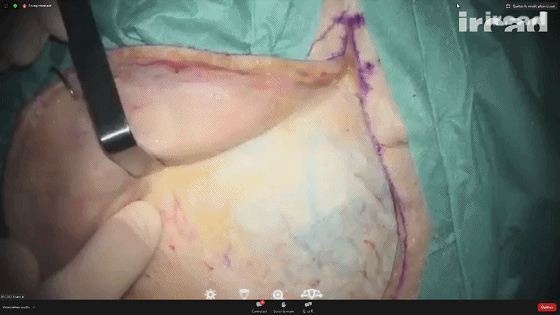
4.显露下方的颞肌,寻找颞肌表面的颞肌浅、深筋膜之间的间隙,沿额颧缝与耳屏的假想线剪开颞肌浅筋膜(详见《筋膜间-骨膜下入路---Rhoton解剖视频学习笔记系列》)。



5.继续用剥离子 在筋膜间暴露出整个颧弓。在骨膜下 钝性剥离额骨颧突,确保额部骨膜层和颞肌筋膜浅层在颞上线内外的延续性。

6.额部的骨膜尽量保留,翻向前方,直至显露出眶上神经和眶上切迹。

7.常可见眶上神经从眶上切迹穿出,可将其从眶上神经沟内轻轻钝性游离出。少数情况下,眶上神经从眶上神经孔内穿出。此时可用细小钻头,绕眶上神经切开一圈,使其连同其骨孔一同向前移位,而不损伤神经。
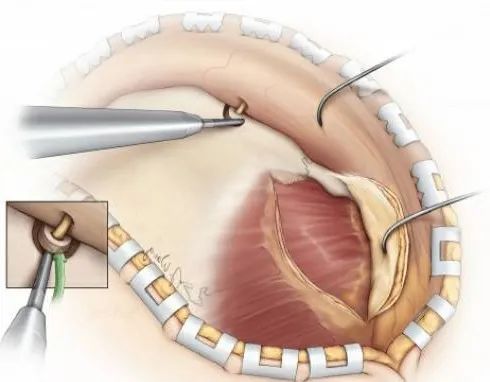
8.沿颞上线切开颞肌,在后方则是平行于头皮切口方向切开肌肉(下图)。在颞上线处保留一条肌筋膜带,以便关颅时修复颞肌。随后用骨膜剥离子对颞肌行骨膜下分离,方向应从下往上,即从颧弓向颞上线进行。

9.将颞肌向下翻转。

10.额骨及颧骨骨膜延续为眶骨膜。 在眶上切迹至眶下裂之间的眶骨膜行广泛的钝性剥离,直至形成明显的眶骨膜下间隙。

11.眶骨膜下分离一定要到达 眶下裂。

12.关建孔(McCarty keyhole):额颧缝、蝶颧缝、额蝶缝 这三条骨缝的交界点。
更简便的方法:用剥离子探查眼眶深度(下图),剥离子尖端大致对应的就是关建孔的眼眶部分。首先磨除眼眶部分。

13.再次磨除关建孔的颅内部分。

14.用椎板咬骨钳 咬扩 两个骨孔。

15.钻孔两个:翼点后上方颞线上、颧弓根部上方的颞骨处

16.斜行铣开颧弓根部。

17.用铣刀 切开从 眶下裂 到 关建孔眶部 的骨质

18.用铣刀头斜行打开眶外侧角的颧骨体
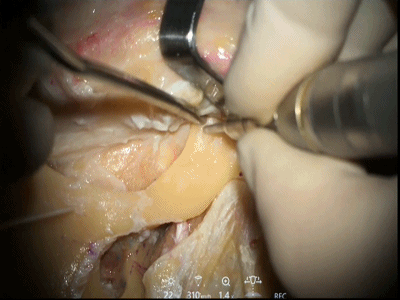
19.用骨凿 凿开残余的骨连接

20.用铣刀 切开上述两骨孔之间的骨质

21.继续向额部铣开,直至尽可能接近 眶上切迹(眶上缘中内 1/3 处)

22.用铣刀反向切开眶上切迹。

23.用骨凿 凿开 关建孔处眶顶骨质

24.用磨钻磨除 关建孔颅内部分 与 蝶骨大翼之间的骨质

25.最后,用骨膜剥离子 撬开、折断 残余未断的眶上壁骨质

26.剪断 附着在颧弓下方的 咬肌肌束。

27.咬除残留的蝶骨大翼

28.可见眶外侧骨膜已暴露,下一步可进行海绵窦入路,首先切开脑膜眶带约5mm

29.沿眶上裂将颞窝硬脑膜从海绵窦外侧壁上钝性剥离开。

30.继续向外剥离,可暴露三叉神经V1、V2

31.再向外侧可暴露 三叉神经 V3 、脑膜中动脉

32.可继续磨除前床突(详见《前床突磨除技术(上篇)---我的手术学习笔记系列》)

33.将前床突末端取出。

34.去除前床突后,颈内动脉及海绵窦内神经、血管可一览无余。
下图示 打开 滑车下三角(Parkinson三角)

35.滑车下三角深方可见 颈内动脉(海绵窦段),外展神经(位于V1内侧)。滑车神经上方为动眼神经。

36.进一步剪开 动眼神经周围的硬膜,深方为动眼神经三角

37. T型剪开硬脑膜,基底指向眶尖

38. 剪开包绕颈内动脉的远环硬膜

39.观察第二间隙:大脑前动脉、后交通动脉、基底动脉

40.观察第三间隙:脉络膜前动脉、大脑后动脉、小脑上动脉。

41.最后鸟瞰一下 额颞眶颧入路的暴露范围。




